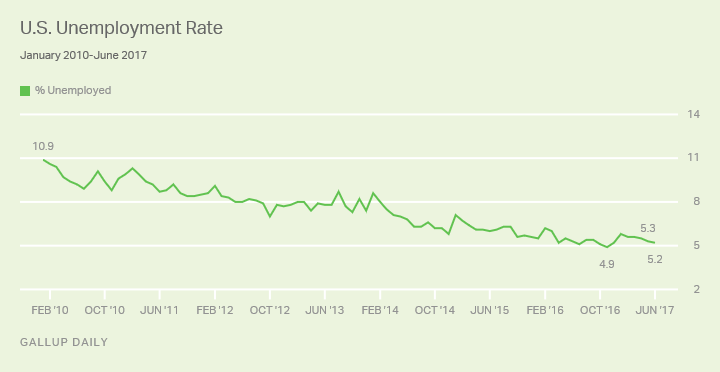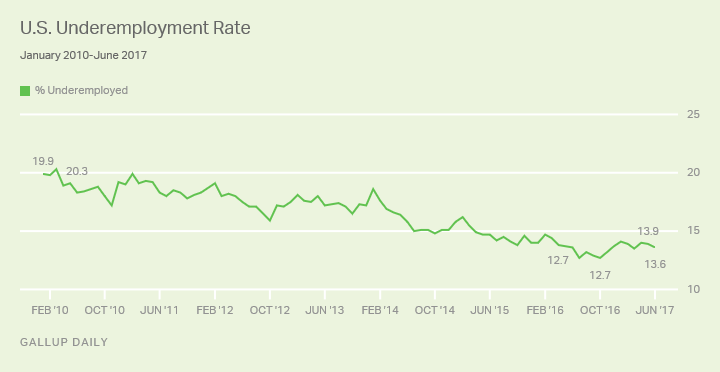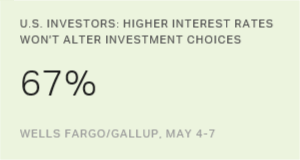Story Highlights
- Gallup Good Jobs rate at 46.3% in June, up from 45.4% in May
- Workforce participation rate at record-high 68.6%
- Unemployment and underemployment rates hold steady
WASHINGTON, D.C. -- The U.S. Gallup Good Jobs (GGJ) rate, which measures the percentage of the U.S. adult population with full-time jobs, rose to 46.3% in June, up from 45.4% in May. This is the highest level so far in 2017. The current level is roughly equal to the rate in June 2016, when the GGJ stood at 46.0%.

These latest data come from a survey of more than 30,000 U.S. adults, conducted from June 1-30.
Since Gallup first began tracking this measure in 2010, the GGJ rate has always risen between May and June. The current increase of nearly a full percentage point is higher than the average increase of 0.6 points from May to June.
While the June 2017 GGJ rate falls short of the high point of 47.1% that Gallup recorded in July 2016, it is two points above the average for the rate since its inception in 2010 -- 44.3%. It is also nearly five points higher than the low point of 41.7%, recorded in February 2011 as the U.S. economy was still recovering from the Great Recession.
The GGJ rate is the percentage of U.S. adults, aged 18 or older, who are employed on a full-time basis -- at least 30 hours a week -- by an employer. Individuals who are self-employed, work fewer than 30 hours a week, are unemployed or are out of the workforce are not counted as being full-time employed. The GGJ metric measures only whether someone is employed full time by an employer and does not reflect job satisfaction or compensation. GGJ is not seasonally adjusted.
Workforce Participation at Record High
U.S. workforce participation rose to 68.6% in June, a record high since Gallup began tracking the measure, though it is equivalent to the 68.5% rates in April and June 2013. The participation rate is up from 68.0% in May and is more than one point higher than it was in June a year ago, when it averaged 67.5%.
Gallup's workforce participation rate is the percentage of U.S. adults aged 18 or older who work full or part time, or who are currently not employed but are actively seeking work.

Unemployment Essentially Unchanged in June
Gallup's U.S. unemployment rate for June was 5.2%, virtually unchanged from 5.3% in May. It matches the rate of 5.3% in June 2016. The unemployment rate is near the record low of 4.9% Gallup recorded in November 2016, and well below the high point of 10.9% recorded at the outset of Gallup's tracking of this metric in January 2010.

Whereas the GGJ rate is based on the total U.S. adult population, both the Gallup and U.S. Bureau of Labor Statistics (BLS) unemployment rates are percentages of the labor force, defined as those who are working or seeking work. While the Gallup and BLS measures are similar, there are methodological differences between the two. These differences are outlined at the end of this article.
Perhaps the most significant difference is that the BLS seasonally adjusts its most commonly used measure of unemployment, while Gallup does not. Gallup's measure is strongly related to the metric that the BLS releases. However, the two measures do not always match on a monthly basis.
Underemployment Holds Steady in June
The underemployment rate for U.S. adults was essentially unchanged at 13.6% in June, compared to 13.9% in May. The current underemployment rate is the same as was recorded in June of last year, though well below the high of 20.3% in March 2010. Underemployment was slightly lower in the second half of 2016.
Gallup's measure of underemployment is a combination of U.S. adults in the workforce who are unemployed (5.2%) and those who are working part-time jobs, but desire full-time work (8.4%).

Bottom Line
Two of Gallup's economic measures, the GGJ rate and the workforce participation rate, improved in June, while the unemployment and underemployment rates held steady at fairly low levels. Another Gallup economic measure, the Job Creation Index, was near a record high in June. These Gallup measures, combined with the continued growth of the stock market and BLS reports that unemployment has reached a 16-year low, suggest the U.S. economy remains strong. Based on the apparent strength of the economy and the history of the GGJ rate, it is likely to hold steady or increase from June to July. These two months are typically the high points in each year, because of the seasonal patterns of employment.
The continued strength of the economy as measured by these indicators could benefit the Trump administration. In fact, the president has repeatedly touted his role in the economy's success. Americans -- albeit less than a majority -- give Trump some of his highest approval ratings on his handling of the economy.
These data are available in Gallup Analytics.
Gallup.com reports results from these indexes in daily, weekly, and monthly averages and in Gallup.com stories. Complete trend data are always available to view in the following charts:
Daily: Employment, Economic Confidence, Job Creation, Consumer Spending
Weekly: Employment, Economic Confidence, Job Creation, Consumer Spending
Read more about Gallup's economic measures.
View our economic release schedule.
| Most recent month (Jun 2017) | Previous month (May 2017) | Month a year ago (Jun 2016) | |||||||||||||||||||||||||||||||||||||||||||||||||||||||||||||||||||||||||||||||||||||||||||||||||
|---|---|---|---|---|---|---|---|---|---|---|---|---|---|---|---|---|---|---|---|---|---|---|---|---|---|---|---|---|---|---|---|---|---|---|---|---|---|---|---|---|---|---|---|---|---|---|---|---|---|---|---|---|---|---|---|---|---|---|---|---|---|---|---|---|---|---|---|---|---|---|---|---|---|---|---|---|---|---|---|---|---|---|---|---|---|---|---|---|---|---|---|---|---|---|---|---|---|---|---|
| % | % | % | |||||||||||||||||||||||||||||||||||||||||||||||||||||||||||||||||||||||||||||||||||||||||||||||||
| Employed full time for an employer (GGJ)* | 46.3 | 45.4 | 46.0 | ||||||||||||||||||||||||||||||||||||||||||||||||||||||||||||||||||||||||||||||||||||||||||||||||
| Employed full time for self* | 6.1 | 6.3 | 5.7 | ||||||||||||||||||||||||||||||||||||||||||||||||||||||||||||||||||||||||||||||||||||||||||||||||
| Workforce participation rate* | 68.6 | 68.0 | 67.5 | ||||||||||||||||||||||||||||||||||||||||||||||||||||||||||||||||||||||||||||||||||||||||||||||||
| Unemployment rate** | 5.2 | 5.3 | 5.3 | ||||||||||||||||||||||||||||||||||||||||||||||||||||||||||||||||||||||||||||||||||||||||||||||||
| Employed part time, wanting full time** | 8.4 | 8.5 | 8.3 | ||||||||||||||||||||||||||||||||||||||||||||||||||||||||||||||||||||||||||||||||||||||||||||||||
| Underemployment rate** | 13.6 | 13.9 | 13.6 | ||||||||||||||||||||||||||||||||||||||||||||||||||||||||||||||||||||||||||||||||||||||||||||||||
| *Metrics represent percentages of the population aged 18+ who have a job or are actively seeking work. **Metrics represent percentages of the workforce. | |||||||||||||||||||||||||||||||||||||||||||||||||||||||||||||||||||||||||||||||||||||||||||||||||||
| GALLUP DAILY | |||||||||||||||||||||||||||||||||||||||||||||||||||||||||||||||||||||||||||||||||||||||||||||||||||
| Gallup | U.S. Bureau of Labor Statistics | ||||||||||||||||||||||||||||||||||||||||||||||||||||||||||||||||||||||||||||||||||||||||||||||||||
|---|---|---|---|---|---|---|---|---|---|---|---|---|---|---|---|---|---|---|---|---|---|---|---|---|---|---|---|---|---|---|---|---|---|---|---|---|---|---|---|---|---|---|---|---|---|---|---|---|---|---|---|---|---|---|---|---|---|---|---|---|---|---|---|---|---|---|---|---|---|---|---|---|---|---|---|---|---|---|---|---|---|---|---|---|---|---|---|---|---|---|---|---|---|---|---|---|---|---|---|
| Population | 18 and older | 16 and older | |||||||||||||||||||||||||||||||||||||||||||||||||||||||||||||||||||||||||||||||||||||||||||||||||
| Adjustments | Not seasonally adjusted | Seasonally adjusted | |||||||||||||||||||||||||||||||||||||||||||||||||||||||||||||||||||||||||||||||||||||||||||||||||
| Sample size | 30,000 individuals per month | 60,000 households per month | |||||||||||||||||||||||||||||||||||||||||||||||||||||||||||||||||||||||||||||||||||||||||||||||||
| Mode of interview | RDD telephone, including cellphones | Rotating panel with face-to-face and telephone interviewing | |||||||||||||||||||||||||||||||||||||||||||||||||||||||||||||||||||||||||||||||||||||||||||||||||
| Data collection period | Continuous | One-week reference period occurring mid-month | |||||||||||||||||||||||||||||||||||||||||||||||||||||||||||||||||||||||||||||||||||||||||||||||||
| Reporting frequency | Daily, weekly, monthly, based on 30-day rolling averages | Monthly, based on one-week reference period | |||||||||||||||||||||||||||||||||||||||||||||||||||||||||||||||||||||||||||||||||||||||||||||||||
| Gallup | |||||||||||||||||||||||||||||||||||||||||||||||||||||||||||||||||||||||||||||||||||||||||||||||||||
Survey Methods
Results for this Gallup poll are based on telephone interviews conducted June 1-30, 2017, on the Gallup U.S. Daily survey, with a random sample of 30,475 adults, aged 18 and older, living in all 50 U.S. states and the District of Columbia. For results based on the total sample of national adults, the margin of sampling error is ±1 percentage point at the 95% confidence level. All reported margins of sampling error include computed design effects for weighting.
Each sample of national adults includes a minimum quota of 70% cellphone respondents and 30% landline respondents, with additional minimum quotas by time zone within region. Landline and cellular telephone numbers are selected using random-digit-dial methods.
Learn more about how the Gallup U.S. Daily works.




